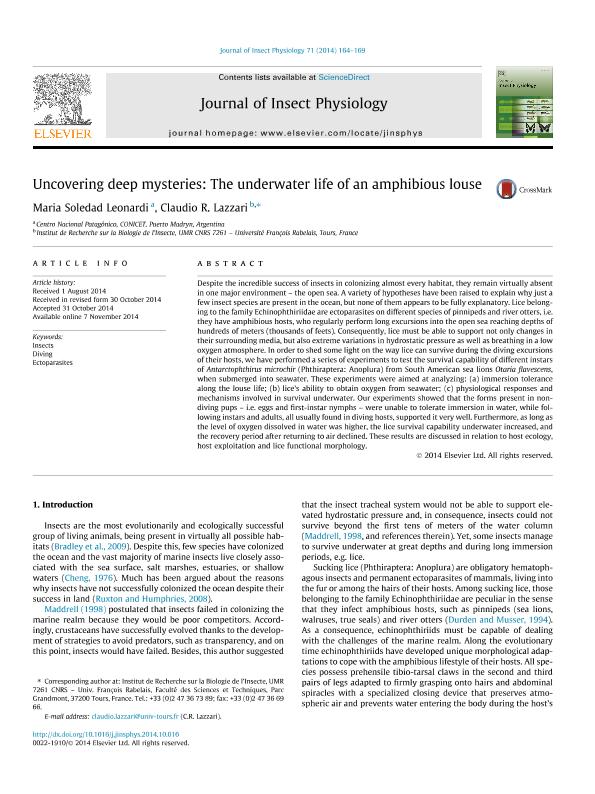Mostrar el registro sencillo del ítem
dc.contributor.author
Leonardi, María Soledad

dc.contributor.author
Lazzari, Claudio Ricardo

dc.date.available
2017-07-21T18:00:37Z
dc.date.issued
2014-11-07
dc.identifier.citation
Leonardi, María Soledad; Lazzari, Claudio Ricardo; Uncovering deep mysteries: The underwater life of an amphibious louse; Elsevier; Journal of Insect Physiology; 71; 7-11-2014; 164-169
dc.identifier.issn
0022-1910
dc.identifier.uri
http://hdl.handle.net/11336/21094
dc.description.abstract
Despite the incredible success of insects in colonizing almost every habitat, they remain virtually absent in one major environment – the open sea. A variety of hypotheses have been raised to explain why just a few insect species are present in the ocean, but none of them appears to be fully explanatory. Lice belonging to the family Echinophthiriidae are ectoparasites on different species of pinnipeds and river otters, i.e. they have amphibious hosts, who regularly perform long excursions into the open sea reaching depths of hundreds of meters (thousands of feets). Consequently, lice must be able to support not only changes in their surrounding media, but also extreme variations in hydrostatic pressure as well as breathing in a low oxygen atmosphere. In order to shed some light on the way lice can survive during the diving excursions of their hosts, we have performed a series of experiments to test the survival capability of different instars of Antarctophthirus microchir (Phthiraptera: Anoplura) from South American sea lions Otaria flavescens, when submerged into seawater. These experiments were aimed at analyzing: (a) immersion tolerance along the louse life; (b) lice’s ability to obtain oxygen from seawater; (c) physiological responses and mechanisms involved in survival underwater. Our experiments showed that the forms present in nondiving pups – i.e. eggs and first-instar nymphs – were unable to tolerate immersion in water, while fol- lowing instars and adults, all usually found in diving hosts, supported it very well. Furthermore, as long as the level of oxygen dissolved in water was higher, the lice survival capability underwater increased, and the recovery period after returning to air declined. These results are discussed in relation to host ecology, host exploitation and lice functional morphology.
dc.format
application/pdf
dc.language.iso
eng
dc.publisher
Elsevier

dc.rights
info:eu-repo/semantics/openAccess
dc.rights.uri
https://creativecommons.org/licenses/by-nc-sa/2.5/ar/
dc.subject
Amphibious Louse
dc.subject
Antarctophthirus Microchir
dc.subject
Otaria Flavescens
dc.subject
South American Sea Lion
dc.subject
Physiology
dc.subject
Insects
dc.subject
Diving
dc.subject
Ectoparasites
dc.subject.classification
Zoología, Ornitología, Entomología, Etología

dc.subject.classification
Ciencias Biológicas

dc.subject.classification
CIENCIAS NATURALES Y EXACTAS

dc.title
Uncovering deep mysteries: The underwater life of an amphibious louse
dc.type
info:eu-repo/semantics/article
dc.type
info:ar-repo/semantics/artículo
dc.type
info:eu-repo/semantics/publishedVersion
dc.date.updated
2017-06-30T13:28:07Z
dc.journal.volume
71
dc.journal.pagination
164-169
dc.journal.pais
Países Bajos

dc.journal.ciudad
Amsterdam
dc.description.fil
Fil: Leonardi, María Soledad. Consejo Nacional de Investigaciones Científicas y Técnicas. Centro Científico Tecnológico Conicet - Centro Nacional Patagónico; Argentina
dc.description.fil
Fil: Lazzari, Claudio Ricardo. Université François Rabelais; Francia. Consejo Nacional de Investigaciones Científicas y Técnicas; Argentina
dc.journal.title
Journal of Insect Physiology

dc.relation.alternativeid
info:eu-repo/semantics/altIdentifier/doi/http://dx.doi.org/10.1016/j.jinsphys.2014.10.016
dc.relation.alternativeid
info:eu-repo/semantics/altIdentifier/url/http://www.sciencedirect.com/science/article/pii/S002219101400211X
Archivos asociados
